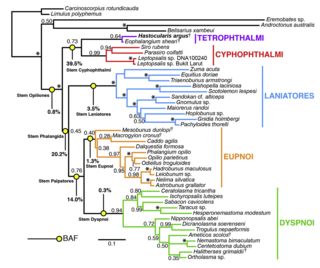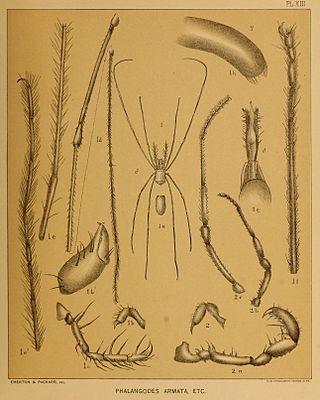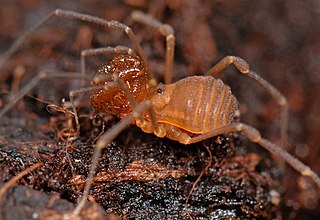Related Research Articles

Arachnida is a class of joint-legged arthropods, in the subphylum Chelicerata. Arachnida includes, among others, spiders, scorpions, ticks, mites, pseudoscorpions, harvestmen, camel spiders, whip spiders and vinegaroons.

The Opiliones are an order of arachnids colloquially known as harvestmen, harvesters, harvest spiders, or daddy longlegs. As of April 2017, over 6,650 species of harvestmen have been discovered worldwide, although the total number of extant species may exceed 10,000. The order Opiliones includes five suborders: Cyphophthalmi, Eupnoi, Dyspnoi, Laniatores, and Tetrophthalmi, which were named in 2014.

Sea spiders are marine arthropods of the order Pantopoda, belonging to the class Pycnogonida, hence they are also called pycnogonids. They are cosmopolitan, found in oceans around the world. The over 1,300 known species have leg spans ranging from 1 mm (0.04 in) to over 70 cm (2.3 ft). Most are toward the smaller end of this range in relatively shallow depths; however, they can grow to be quite large in Antarctic and deep waters.

Cyphophthalmi is a suborder of harvestmen, colloquially known as mite harvestmen. Cyphophthalmi comprises 36 genera, and more than two hundred described species. The six families are currently grouped into three infraorders: the Boreophthalmi, Scopulophthalmi, and Sternophthalmi.

Dromopoda is a proposed subclass of the arachnids, including the Opiliones (harvestmen), Scorpions, Pseudoscorpions and Solifugae. The latter three are sometimes grouped as Novogenuata. Combined morphological and molecular analyses have shown Dromopoda to be monophyletic. However, a strictly molecular analysis did not support the monophyly of Dromopoda.

Phalangium opilio is a species of harvestman belonging to the family Phalangiidae.

Troglosironidae is a family of harvestmen with seventeen described species in a single genus, Troglosiro, which is found on the island of New Caledonia, in the Pacific Ocean.

The Neogoveidae are a family of harvestmen with 27 described species in eight genera. However, eight species of Huitaca, 17 species of Metagovea and 12 species of Neogovea are currently awaiting description.

Ischyropsalididae is a family of harvestmen with 35 described species in 3 genera, found in Europe and North America.

Harvestmen (Opiliones) are an order of arachnids often confused with spiders, though the two orders are not closely related. Research on harvestman phylogeny is in a state of flux. While some families are clearly monophyletic, that is share a common ancestor, others are not, and the relationships between families are often not well understood.

Theromaster brunneus is a species of armoured harvestman in the family Travuniidae. It is found in North America.

Theromaster is a genus of armoured harvestmen in the family Cladonychiidae. There are at least two described species in Theromaster, found in the eastern United States.

Travunioidea is a superfamily of armoured harvestmen in the order Opiliones. There are 4 families and more than 70 described species in Travunioidea.
Wespus is a genus of armoured harvestmen in the family Phalangodidae. There is at least one described species in Wespus, W. arkansasensis.

Siro exilis is a species of mite harvestman in the family Sironidae. It is found in North America.

Phalangodes is a genus of armoured harvestmen in the family Phalangodidae. There is at least one described species in Phalangodes, P. armata.

Gregory Donald Edgecombe is a merit researcher in the department of Earth Sciences at the Natural History Museum, London. He is a leading figure in understanding the evolution of arthropods, their position in animal evolution and the integration of fossil data into analyses of animal phylogeny. As a palaeontologist, he is also an authority on the systematics of centipedes – and a morphologist whose work contributes to the growth and methods of analysis of molecular datasets for inferring evolutionary relationships.

Cryptomastridae is a family of armoured harvestmen in the order Opiliones. There are two genera and four described species in Cryptomastridae, found in Oregon and Idaho.
Prashant P. Sharma is an Indian-American invertebrate biologist and a professor of Integrative Biology at the University of Wisconsin-Madison.
References
- ↑ "Current fellow" . Retrieved February 7, 2019.
- ↑ "Learning through doing". Harvard Gazette. June 11, 2013. Retrieved February 19, 2015.
- ↑ "Gonzalo Giribet". Harvard University. Retrieved February 7, 2019.
- 1 2 Alvin Powell (November 20, 2007). "Gonzalo Giribet: A life of biodiversity". Harvard Gazette . Retrieved February 7, 2019.
- ↑ Stephanie Kacoyanis (May 3, 2017). "5 awarded Harvard College Professorships". The Harvard Gazette. Retrieved February 7, 2019.
- ↑ Gonzalo Giribet; Salvador Carranza; Jaume Bagui; Marta Riutort; Caries Ribera (1996). "First Molecular Evidence for the Existence of a Tardigrada + Arthropoda Clade". Molecular Biology and Evolution . 13 (1): 76–84. doi: 10.1093/oxfordjournals.molbev.a025573 . PMID 8583909.
- ↑ Salvador Carranza; Gonzalo Giribet; Caries Ribera,? Jaume Baguii; Marta Riutort (1996). "Evidence that Two Types of 18s rDNA Coexist in the Genome of Dugesia (Schmidtea) mediterranea (Platyhelminthes, Turbellaria, Tricladida)". Molecular Biology and Evolution. 13 (6): 824–832. doi: 10.1093/oxfordjournals.molbev.a025643 . PMID 8754218.
- ↑ Gonzalo Giribet; Daniel L. Distel; Martin Polz; Wolfgang Sterrer; Ward C. Wheeler (2000). "Triploblastic Relationships with Emphasis on the Acoelomates and the Position of Gnathostomulida, Cycliophora, Plathelminthes, and Chaetognatha: A Combined Approach of 18S rDNA Sequences and Morphology". Systematic Biology . 49 (3): 539–562. doi: 10.1080/10635159950127385 . PMID 12116426.
- ↑ Gonzalo Giribet; Gregory D. Edgecombe; Ward C. Wheeler (2001). "Arthropod phylogeny based on eight molecular loci and morphology". Nature . 413 (6852): 157–161. Bibcode:2001Natur.413..157G. doi:10.1038/35093097. PMID 11557979. S2CID 4431635.
- ↑ Gonzalo Giribet; Ward Wheeler (November 2002). "On bivalve phylogeny: a high-level analysis of the Bivalvia (Mollusca) based on combined morphology and DNA sequence data". Invertebrate Biology . 121 (4): 271–324. doi: 10.1111/j.1744-7410.2002.tb00132.x .
- ↑ Giribet G, Edgecombe GD, Wheeler WC, Babbitt C (2002). "Phylogeny and Systematic Position of Opiliones: A Combined Analysis of Chelicerate Relationships Using Morphological and Molecular Data". Cladistics . 18 (1): 5–70. doi: 10.1111/j.1096-0031.2002.tb00140.x . PMID 14552352. S2CID 16833833.
- ↑ Giribet, Gonzalo; Vogt, Lars; González, Abel Pérez; Sharma, Prashant; Kury, Adriano B. (August 2010). "A multilocus approach to harvestman (Arachnida: Opiliones) phylogeny with emphasis on biogeography and the systematics of Laniatores". Cladistics. 26 (4): 408–437. doi: 10.1111/j.1096-0031.2009.00296.x .
- ↑ Jon Mallatt; Gonzalo Giribet (2006). "Further use of nearly complete 28S and 18S rRNA genes to classify Ecdysozoa: 37 more arthropods and a kinorhynch". Molecular Phylogenetics and Evolution. 40 (1): 772–794. doi:10.1016/j.ympev.2006.04.021. PMID 16781168.
- ↑ Alvin Powell (October 5, 2006). "Arthropods invade Harvard Museum of Natural History". Harvard Gazette. Retrieved February 7, 2019.
- ↑ Carl Zimmer (August 28, 2007). "A Daddy Longlegs Tells the Story of the Continents' Big Shifts". The New York Times . Retrieved February 7, 2019.
- ↑ Hejnol A, Obst M, Stamatakis A, et al. (2009). "Assessing the root of bilaterian animals with scalable phylogenomic methods". Proceedings of the Royal Society B . 276 (1677): 4261–70. doi:10.1098/rspb.2009.0896. PMC 2817096 . PMID 19759036.
- ↑ Alvin Powell (March 4, 2010). "Deep thinking". Harvard Gazette. Retrieved February 7, 2019.
- ↑ Ballesteros, Jesús A; Santibáñez-López, Carlos E; Baker, Caitlin M; Benavides, Ligia R; Cunha, Tauana J; Gainett, Guilherme; Ontano, Andrew Z; Setton, Emily V W; Arango, Claudia P; Gavish-Regev, Efrat; Harvey, Mark S; Wheeler, Ward C; Hormiga, Gustavo; Giribet, Gonzalo; Sharma, Prashant P (2022-02-03). Teeling, Emma (ed.). "Comprehensive Species Sampling and Sophisticated Algorithmic Approaches Refute the Monophyly of Arachnida". Molecular Biology and Evolution. 39 (2): msac021. doi:10.1093/molbev/msac021. ISSN 0737-4038. PMC 8845124 . PMID 35137183.
- ↑ Sato, Shoyo; Cunha, Tauana J; de Medeiros, Bruno A S; Khost, Danielle E; Sackton, Timothy B; Giribet, Gonzalo (2023-03-03). Vieira, Cristina (ed.). "Sizing Up the Onychophoran Genome: Repeats, Introns, and Gene Family Expansion Contribute to Genome Gigantism in Epiperipatus broadwayi". Genome Biology and Evolution. 15 (3): evad021. doi:10.1093/gbe/evad021. ISSN 1759-6653. PMC 9985152 . PMID 36790097.
- ↑ Christina Pazzanese (June 16, 2015). "Race ready". Harvard Gazette . Retrieved February 7, 2019.